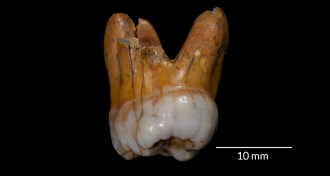News in Brief
-
 Astronomy
AstronomyMore mysterious extragalactic signals detected
Five more fast radio bursts from other galaxies have shown up and one of them is a double.
-
 Life
LifeDNA doubled in conifer ancestors
The genomes of conifers — pine, cypress and yew trees — doubled twice in the distant past.
-
 Neuroscience
NeuroscienceTaste is all in your head
By targeting certain nerve cells in a mouse’s brain, scientists made plain water turn bitter or sweet.
-
 Planetary Science
Planetary SciencePhobos to create ring around the Red Planet
Mars’ moon Phobos will shatter and create a temporary ring around Mars 20 million to 40 million years from now.
-
 Tech
TechRoses rigged with electrical circuits
Bioelectric molecules can form wires and conduct electricity in cut roses, researchers find.
-
 Planetary Science
Planetary ScienceGlimpse of baby planet shows what to expect when a star is expecting
A baby planet is still growing in the disk of gas that encircles a young star.
-
 Plants
PlantsAncient gardeners saved the gourd
Domestication might have helped early vine plants like pumpkin survive after seed-dispersing megafauna went extinct.
-
 Health & Medicine
Health & MedicineStudy brews up more evidence for coffee’s health benefits
Drinking up to five cups of coffee a day reduced the risk of dying early from heart and brain diseases and suicide.
-
 Anthropology
AnthropologyDNA puts Neandertal relatives in Siberia for 60,000 years
Recovered DNA suggests Denisovans inhabited Siberia for around 60,000 years.
By Bruce Bower -
 Planetary Science
Planetary ScienceMighty winds fuel megastorms on Titan
Saturn’s moon Titan might produce long-lasting storms squalls that flood the surface with liquid methane.
-
 Health & Medicine
Health & MedicineBlood-brain barrier jiggled loose to deliver medicine
Using ultrasounds, doctors attempted to slip a chemotherapy drug into a woman’s brain through the blood-brain barrier.
-
 Health & Medicine
Health & MedicineCardiac risks rise for linemen during football season
Linemen on a football team face raised cardiac risk over the course of a season, a study of college players shows.
By Laura Beil